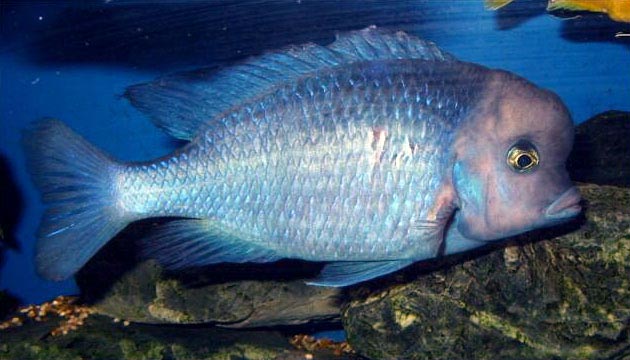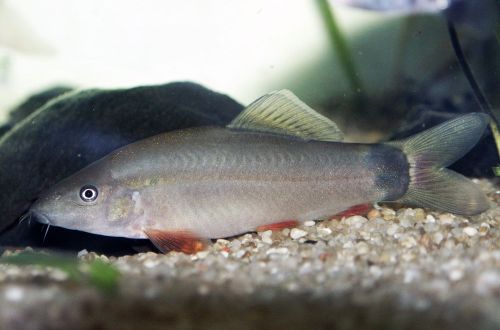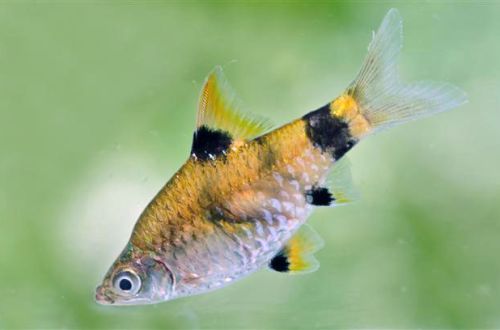
“Blue Dolphin”
The Blue Dolphin cichlid, scientific name Cyrtocara moorii, belongs to the Cichlidae family. The fish got its name due to the presence of an occipital hump on the head and a somewhat elongated mouth, which vaguely resembles the profile of a dolphin. The etymology of the genus Cyrtocara also indicates this morphological feature: the words “cyrtos” and “kara” in Greek mean “bulging” and “face”.

Contents
Habitat
Endemic to Lake Nyasa in Africa, one of the largest freshwater reservoirs on the continent. It occurs throughout the lake near the coastline with sandy substrates at depths of up to 10 meters.
Brief information:
- The volume of the aquarium is from 250–300 liters.
- Temperature – 24-28°C
- Value pH — 7.6–9.0
- Water hardness – medium to high hardness (10-25 dGH)
- Substrate type – sandy
- Lighting – moderate
- Brackish water – no
- Water movement is weak
- The size of the fish is up to 20 cm.
- Nutrition – any sinking food rich in protein
- Temperament – conditionally peaceful
- Keeping in a harem with one male and several females
Description

Males reach a length of up to 20 cm. Females are somewhat smaller – 16–17 cm. The fish have a bright blue body color. Depending on the specific geographical form, dark vertical stripes or irregularly shaped spots may be present on the sides.
The fry are not so brightly colored and have predominantly gray shades. Blue shades begin to appear when they reach a size of about 4 cm.
Food
In their natural habitat, the fish have developed an unusual foraging strategy. They accompany larger cichlids that feed by sifting sand from the bottom in search of small invertebrates (insect larvae, crustaceans, worms, etc.). Anything left uneaten goes to the Blue Dolphin.
In a home aquarium, the feeding strategy changes, the fish will consume any available food, for example, popular dry sinking foods in the form of flakes and granules, as well as daphnia, bloodworms, brine shrimp, etc.
Maintenance and care
Lake Malawi has a stable hydrochemical composition with high total hardness (dGH) and alkaline pH values. Similar conditions will need to be recreated in a home aquarium.
Arrangement is arbitrary. The most natural fish will look among the heaps of stones around the perimeter of the tank and the sandy substrate. Limestone decorations are a good choice as they increase carbonate hardness and pH stability. The presence of aquatic plants is not required.
Maintenance of an aquarium is largely determined by the availability of installed equipment. Nevertheless, several procedures are mandatory in any case – this is the weekly replacement of part of the water with fresh water and the removal of accumulated organic waste (feed residues, excrement).
Behavior and Compatibility
A relatively peaceful species of cichlids, it is possible to keep them together with other non-aggressive representatives of Lake Nyasa, such as the Utaka and Aulonocara cichlids and other fish of a comparable size that can live in an alkaline environment. In order to avoid excessive intraspecific competition in the limited space of the aquarium, it is desirable to maintain a group composition with one male and several females.
Breeding / Reproduction
The fish reach sexual maturity by 10–12 cm. Under favorable conditions, spawning occurs several times a year. The approach of the breeding season can be determined by the behavioral characteristics of the male, which begins to prepare a place for spawning. It can be both recesses (holes), and to clean the surface of flat stones from the surface.
After a short courtship, the female alternately lays several dozen oval yellowish eggs. After fertilization, the eggs immediately find themselves in the female’s mouth, where they will stay for the entire incubation period, which is 18–21 days.
Fish diseases
In favorable conditions, health problems do not arise. The main cause of ailments is the unsatisfactory condition of the water, which provokes various skin diseases, the appearance of parasites, etc. For more information about the symptoms and methods of treatment, see the section “Diseases of aquarium fish”.





